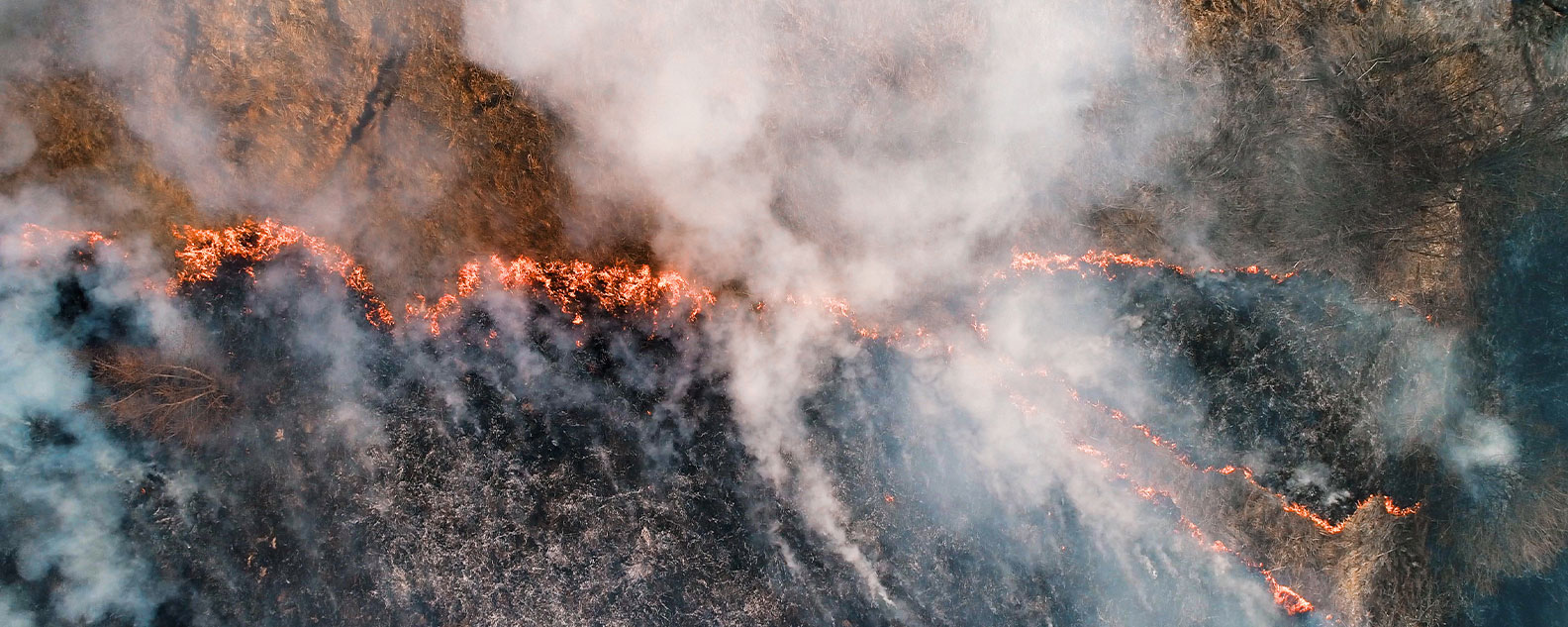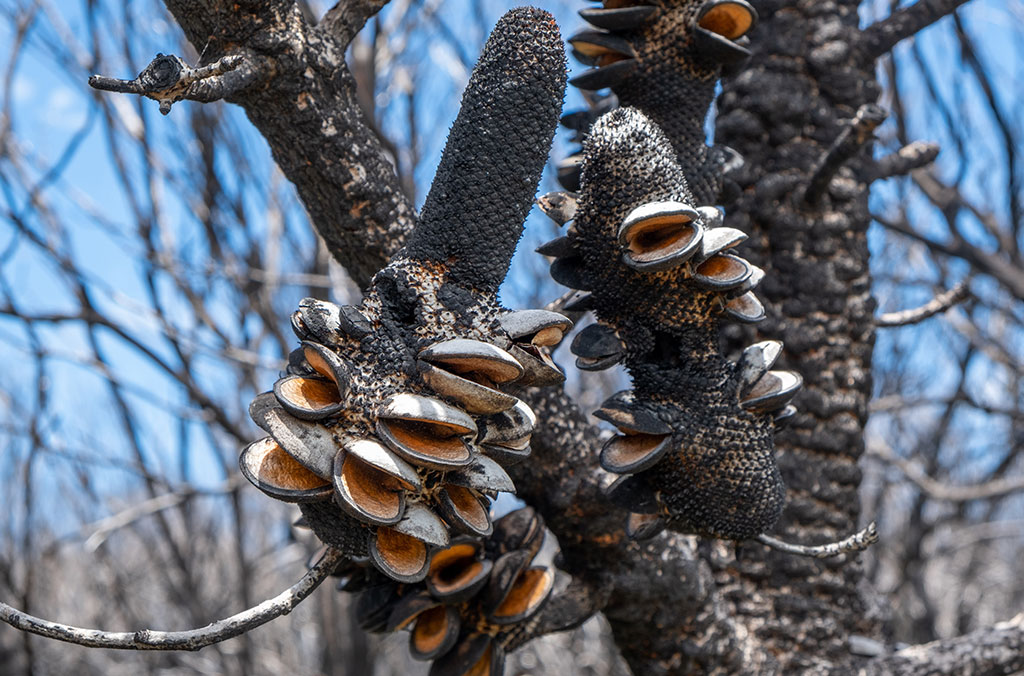Impacting events
Impacting events are naturally recurring episodic events that have a severe, often immediate, impact on the woodland plants, but which they are generally able to cope with and recover, though sometimes with marked changes in population abundance.

Periodic fire is a natural part of many Australian environments, and plays an important part in the ecology of Sydney’s bushland generally. Cumberland Plain Woodland plants have been exposed to fire during their past, and are adapted to survive and respond in different ways.
Aboriginal people would have set fires in the woodland to burn through prickly shrubs and dry grass, and to flush out kangaroos or wallabies. After the fire, it’s easier to walk through the woodland, with shrubby obstacles removed. Later, after some rain, grasses resprout, attracting kangaroos and wallabies to graze on the new growth and concentrate in the burnt area. Fire made hunting easier.
Our work on the fire responses of individual native species has shown that the majority of species survive fire as adults - 90% - by resprouting either from epicormic shoots, or from persistent rootstocks or tubers. The only species that are killed outright are some annual and short-lived species and a couple of shrub species, particularly the shrub Dodonaea viscosa. Many of the exotic species also resprout, but a higher proportion of them are likely to be killed.
However the main issue is fire frequency, and the time interval between successive fires. Too frequent fires may kill off fire resistant species in their juvenile stage before they have developed fire resistance and fire-sensitive species before they mature and produce more seed. Two of our experimental burns have been 10 years apart, and this does not appear to have caused any loss of native species.
Periodic fire may be used to help control some perennial exotic species particularly *Olea europaea subsp. cuspidata, by killing juvenile plants before they become fire resistant.
On the other hand, in some areas unburned for at least 20 years there has been some decrease in above-ground native species richness in the absence of fire, but it is likely these species remain in the soil seedbank. But fire is not a major driver of floristic change
We earlier thought that fire played the major role in determining recruitment and floristic patterns in the woodland but while it clearly contributes to structural features in the woodland, fire does not appear to lead to extensive floristic turnover or change. Our recent observations are now leading us to the view that periodic drought and drought-breaking rains are major factors in determining recruitment and floristic change in the woodland.
Fire may create suitable open space, reduced canopy cover, and may promote vigorous flowering and seeding of pre-existing plants, thus contributing to subsequent soil seedbanks, but is not a major driver of seedling recruitment.
To see some of the species that resprout after fire, view the seedling picture gallery.
Asterisk * indicates exotic species naturalised at the Australian Botanic Garden.
Periods of drought are part of the natural environment of western Sydney, and most native plant species have strategies to survive.
The most common feature of many Cumberland Plain Woodland ground species is the possession of a thickened rootstock either as a taproot or cluster of roots or tuber or rhizome e.g. Brunoniella australis. During dry periods the leaves die and the plant retreats to the persistent rootstock to reshoot when moisture conditions improve. Many monocot species also have thickened roots or tubers. e.g. Arthropodium sp. B. While grasses do not have thickened roots many are also able to die back in dry periods and resprout when conditions improve. Most of these species are long-lived perennials.
Species that have developed the ability to resprout from rootstocks after dying back in response to drought, are also likely to be able to resprout when their top growth is removed by fire. In fact, 85% of our species have the ability to resprout, and use this as the predominant method of survival and persistence from year to year, through either drought or fire.
The 15% of non-resprouters, are not just 'annuals'. Their behaviour ranges from that of regular annual to very irregular ephemeral. Short-lived ephemeral species avoid drought conditions by having short-lived adult stages, and persist through drought as long-lived seed in the soil seedbank e.g. Ranunculus sessiliflorus, Daucus glochidiatus. These non-resprouters have an interesting variety of seed dormancy characteristics and germination cues, as germination opportunities will be episodic, perhaps ocurring only once in a decade e.g. for Daucus glochidiatus, Ranunculus sessiliflorus.
Tree death related to drought
An extended episode of selective tree death occurred over the 1988-95 period in our Australian Botanic Garden woodland.
Plant species may be subject to periodic plagues of predators or diseases. Widespread dieback and death of mature trees has occurred on a large scale in many NSW woodland areas, particularly on the Tablelands. Factors implicated in dieback include ageing of isolated remnant trees and little natural replacement due to grazing of seedlings, combined with a buildup of leaf-eating insects and increased levels of pasture nutrients that favour the larval stages of these insects.
Impacts of plagues and diseases are most obvious on tree canopy species because of their size and importance, but have doubtless affected other smaller species, but which have not been recorded.
Signs of soil-borne disease such as Phytophthora have not been noted in the woodland, but it is unlikely that many of the native species will be susceptible.
Crown canopy dieback of eucalypts
Crown canopy dieback of eucalypts is periodically noted in Cumberland Plain Woodland remnants in western Sydney, but has not been associated with widespread tree death, perhaps as regeneration of trees in many areas has occurred so there are many young trees. Such periods of leaf attack rarely last more than one or two seasons.
Bell Miner associated dieback
A more localised form of eucalypt decline is Bell Miner associated dieback. Bell Miners, Manorina melanophrys, are insectivorous, territorial birds that live in large colonies covering several hectares. Eucalypt stands colonised by Bell Miners often exhibit symptoms of crown decline, and colonisation by Bell Miners correlates with high densities of leaf damaging psyllids in tree crowns. Bell Miners have colonised the woodland at the Australian Botanic Garden, Mount Annan in the last ten years. Experimental treatment of psyllids by arborists at the Australian Botanic Garden aims to reduce defoliation of Eucalypts.
Natural communities may be invaded by species that do not occur naturally in the area, but have been introduced either deliberately or accidentally by humans. Such species may be plants or animals and are referred to as exotic. While some introduced species may remain in low numbers on the margins of the natural community, others may establish vigorously, changing local conditions and outcompeting native species.
While our Australian Botanic Garden woodland contains a high proportion of exotic plant species, many of these are agricultural weeds that were introduced during the 19th and 20th centuries. In the absence of agricultural practices involving ongoing large scale soil disturbance, and intensive stock grazing, most of these species have become less abundant over the last 20 years, or remain restricted to disturbed sites such as roadside margins or periodically mown areas e.g. *Lolium perenne.
The conservation-management conditions of the last two decades have benefited a few species however, and these pose the main weed threats to the long-term survival of the woodland. The main threat is the African Olive *Olea europea subsp. cuspidata. Other threats are posed by Chilean Needle Grass *Nassella neesiana, which was only noted in the woodland in 1991, St Johns Wort, *Hypericum perforatum and Heliotrope, *Heliotropium amplexicaule. Unlike the agricultural exotics, these species have all invaded the woodland and have spread in the last 20 years; active management is needed to control them. Rhodes Grass *Chloris gayana is persistent and may be difficult to eradicate in grassland areas, but is not generally invasive.
Interestingly there are some genera that have both weed and native species in the woodland e.g. *Sida rhombifolia and Sida corrugata, *Solanum nigrum and Solanum cinereum, *Chloris gayana and Chloris ventricosa, *Sporobolus africanus and Sporobolus creber.
Introduced animals include rabbits, hares and garden snails (which may impact on native species through predation - grazing and herbivory), foxes (through weed seed dispersal), and Honey bees (possible pollination impacts).
Asterisk * indicates exotic species naturalised at the Australian Botanic Garden.
Storms can cause damage to trees particularly by loss of tree branches. This may expose hollows in the trunks providing nesting sites and habitat for wildlife.
Lightning strikes can kill individual trees, and some of the plants growing around their base. Again, the dead trees may provide wildlife habitat. The main benefit of storms is the occasional heavy rainfall that may occur, though in a short intense rainfall event much of this will runoff rather than penetrating the soil.
Find more information and images in Climate and our weather station.
In the Sydney area, future climate change appears likely to lead to higher temperatures and less rainfall.
The drought tolerant adaptations of many of the native plant species in our Cumberland Plain Woodland are likely to allow them to persist for some time under drier conditions. However in the long-term most populations do need some periodic seedling recruitment, and adequate wet periods will be necessary to allow germination and establishment. If such periods become less frequent, it will be important that the seedling recruitment and growth to maturity are successful whenever those less-frequent conditions occur.
Given adequate rainfall events, other threats that are likely to impact on the recruitment of species include inadequate microsites for germination, and increased seedling predation, particularly by exotic species such as rabbits, though artificially high macropod species numbers may also be a threat at that time.
Competition from similarly drought-adapted exotic species may also threaten native species, though other exotic species may be destroyed by extended dry periods.
